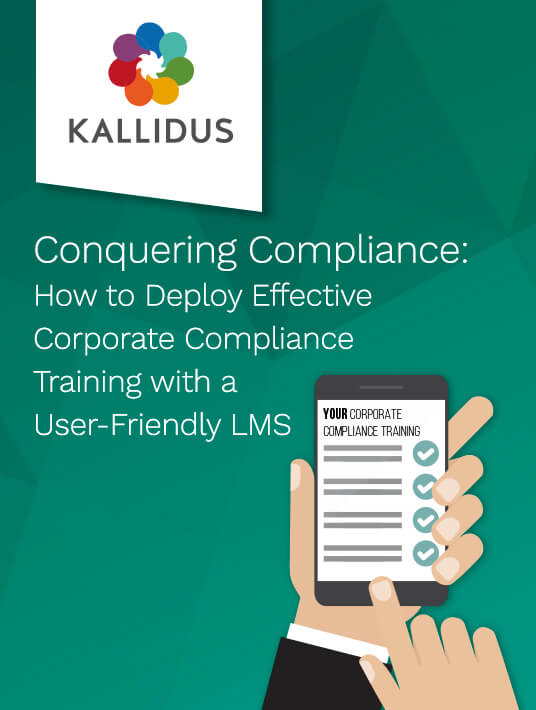Workplace Compliance Trends All L&D Professionals Should Know
In a world of ‘fake news’, spam emails, and instant access to any and all information, it’s no wonder that workplace cynicism is on the rise. According to a case study from Harvard Business Review, the majority of modern employees believe that compliance training is simply there to cover the backs of upper management.

So how can you get your organisation’s staff more actively invested in compliance training? We’ve kept our ears to the ground to provide you with a list of 8 workplace compliance trends every Learning and Development team should consider before rolling out their training.
1. Top-Down Training Models
One of the best ways we’ve seen to re-engage employees who feel like compliance training is just a series of tick-box exercises, is to put the power back in their hands. Using incentives, gamification, and mobile learning are great ways to change attitudes towards learning in any working environment.
Empowering your employees to take control of their own learning environments puts them in the driver’s seat. We’re seeing more and more organisations move away from classroom-based learning and encourage their teams to get more actively involved in their own training. Ιs it time for you to do the same?
2. Anytime, Anywhere Access For Compliance Training
Mobile learning is the perfect platform for compliance training. As opposed to system simulations and behavioural change focused learning, compliance training can be easily broken down into digestible chunks and adapted to the smaller screens of mobile devices. A mobile-optimised LMS interface allows your teams to access their training anytime, anywhere no matter their device of choice.
Don’t get left behind as more organisations move away from classroom-based models of training that can leave staff unengaged - why restrict compliance training to a workplace setting? This is also ideal for any members of your team who work primarily away from an office-based environment who may have limited access to computers.
3. Cross-Device, Mobile-Optimised Learning
We’ve already discussed the importance of mobile learning for the flexibility of your workers, but what about cross-device training? Also known as ‘device agnostic’ compatibility, this means having your training optimised for any number of browsers, operating systems, and models of smartphones and tablets. Regardless of industry, mobile, and tablet use is on the up both in social and work-based situations.
Especially in larger organisations, and those who wish to encourage Bring Your Own Device [BYOD] learning, wide-scale accessibility, and therefore engagement, is only possible if your chosen LMS is fully optimised and thoroughly tested across a broad range of technical specifications.
Continually testing your LMS and content to ensure full compatibility across devices, enables you to deliver a seamless and consistent User Experience to everyone, regardless of preferred learning device and level of digital literacy.
4. Microlearning For Compliance
Whether your workforce is getting their fire safety inductions, GDPR rundowns, or cash handling training, compliance needn’t be a bringer of boredom. Microlearning is the practice of cutting your training into small, easily digestible chunks and is on the increase within eLearning across a huge number of industries.
This improves engagement on two primary levels:
- It plays to short attention spans as it doesn’t require long periods of focus from learners who are used to instant gratification.
- It creates a greater sense of achievement as items on a virtual to-do list are checked off more frequently than one single item at the end of prolonged training.
Bite-sized chunks of information adapt themselves well to multiple devices. So whether your team will be training at a desktop in the office or on-the-go on a mobile or tablet, you’ve got every base covered.
5. Course Gamification
Compliance training isn’t just a legal requirement, it’s about encouraging a healthy working environment through a range of shared skillsets, from cash handling to fire training. Gamification encourages information retention as it actively engages your learners. Fast becoming one of the most popular ways to encourage active engagement, creating in-training quizzes means that your teams are engaging with the materials beyond reading a PDF and ticking a box to say they are done.
Equally, creating ‘top learner’ leaderboards are a great way to encourage healthy competition and motivation to get the training completed quickly and to a high standard. These leaderboards also create a low-level form of reporting for line managers, allowing your L&D teams, and HR managers to spend more time on the rest of their roles and less time chasing those who aren’t caught up.
6. Adaptable, Accessible Content
Compliance training sits in an odd middle-ground within work-based learning environments. Due to the nature of ever-changing compliance guidelines, this training needs to be easily adapted to the latest regulations as well as accessible to everyone across your organisation. Accessibility should be at the forefront of any L&D team’s minds, and any strong LMS should allow your team to dictate your specific needs for bespoke eLearning content.
It’s also important that your compliance training is both fully branded and specific to each team engaging with it. This personalisation factor, something that has now become an expectation across most device-led interactions, has been proven to increase engagement among compliance training. While off-the-shelf content can be useful for large-scale organisations, when it comes to compliance training, bespoke eLearning content holds many benefits.
7. Video-Based Learning
One of the best ways to encourage active learner engagement is through the use of video. This is a form many of your learners will be familiar with and consuming on a daily basis. Did you know that despite contributing less than 5% of its content, videos generate over 80% of all engagement on Facebook? For the sake of attention spans, however, it’s always best to keep videos to 4 minutes or fewer in any e/mLearning environment.
Videos are visually engaging and far more memorable than PDFs, checklists, and other static learning mediums. Interactive animation is a particularly memorable form for eLearning, allowing your staff to actively engage with your content in a simple, easy-to-remember fashion. Simple animation is also particularly user-friendly and accessible across all levels of digital literacy.
8. Engaging Line Managers
One of the most important factors when looking at your compliance training strategy is your workplace learning culture. More and more organisations are looking to get their middle and line management involved in their employees’ training processes. Kallidus Learn, for example, offers specially calibrated management dashboards which allow your line managers to stay more involved in their teams’ progress.
Not only does this take pressure off your L&D and HR departments, but it also helps to ensure a healthy and open relationship regarding learning and development between employees of every level and their management. Feedback and active engagement from line managers are hugely important in keeping staff engaged and motivated. We’re seeing more organisations setting this standard right from the start at the compliance training and induction stages.
There you have it: 8 workplace compliance trends for all Learning and Development teams to keep an eye on. A fantastic User Experience merely scratches the surface of what it means to provide learning your teams can get invested in. Compliance training needn’t be a bore. Keep your learners engaged with visually enticing, memorable content that they can really sink their teeth into. Keep things light, bite-sized, and flexible to get the most out of your workplace compliance training.










